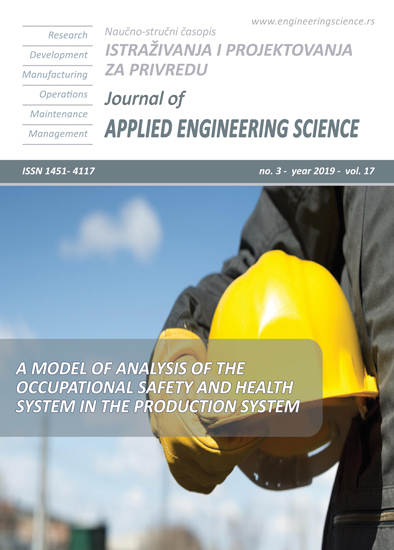ANALYSIS OF CRUISE SHIP TRAFFIC IN THE PORT OF SPLIT
Abstract
Cruise ship traffic is a part of a shipping industry, which is growing constantly both in number of ships and their capacity. Port of Split is second largest cruise port in the Croatia. Many analyses of cruise ship traffic were made for the city of Dubrovnik and some measures for improvement as a result have already been taken. The goal of this paper is to provide detailed analyses of cruise ship traffic in Port of Split as a basis for a future research of carrying capacity of Split’s cruise tourism in aspect of sustainable development.
References
Dundović, Č., Jurić, M. & Kovačić, M. (2013). Optimizing the Split port system to promote sustainable development. Pomorstvo – Scientific Journal of Maritime Research, vol. 27, no. 2, 285-298.
Zanne M. & Beškovnik, B. (2018). Assesing Home Port Potential of Selected Adriatic Ports. TOMS – Transactions on Maritime Science, vol. 7, no. 2, 143-153, DOI: 10.7225/toms.v07.n02.004
Bluewater Network & Friends of the Earth. Ship air pollution, from: http://www.foe.org/projects/oceans-and-forests/cruise-ships, accessed on: 2010-02-20.
CLIA – Cruise Lines International Association. 2019 CLIA State of Cruise Industry Report, from: http://cruising.org, accessed on: 2019-05-25.
FCCA (2018). Cruise Industry Overview 2017: State of the Cruise Industry. Pembroke Pines: Florida-Caribbean Cruise Association.
MedCruise Association. Cruise Activities in MedCruise Ports – 2017 statistics, from: http://www.medcruise.com/sites/default/files/2018-03/cruise_activities_in_medcruise_ports-statistics_2017_final_0.pdf, accessed on: 2019-06-28.
Institute of shipping economics and logistics. Shipping statistics and market review, vol. 54, from: http://www.isl.org, accessed on: 2011-09-07.
Perić, T. & Račić, N. (2019). Cruise ship traffic in the Adriatic Sea: Environmental impact. 8th International Maritime Science Conference (IMSC 2019), p. 49-58.
Cruise Mapper. Cruise ship passenger capacity, from: https://www.cruisemapper.com/wiki/761-cruise-ship-passenger-capacity-ratings, accessed on: 2019-05-17.
Split Port Authority. Port of Split, from: https://portsplit.hr/en/port-of-split/, accessed on: 2019-05-03.
Avoid Crowds. Europe’s busiest cruise ports in 2019, from: https://avoid-crowds.com/europe-busiest-cruise-ports-in-2019/, accessed on: 2019-06-15.
Čokorilo, O. & Čavka, I. (2015). The role of air transport development in Adriatic-Ionian microregion. International Journal for Traffic and Transport Engineering, vol. 5, no. 4, 344-359, DOI: 10.7708/ijtte.2015.5(4).01
Carić, H. (2015). Challenges and prospects of valuation – cruise ship pollution case. Journal of Cleaner Production, Elsevier, vol. 111 (B), 487-498, DOI: 10.1016/j.jclepro.2015.01.033
Butt, N. (2007). The impact of cruise ship generated waste on home ports and ports of call: A study of Southampton. Marine Policy, Elsevier, vol. 31, no. 5, 591-598, DOI: 10.1016/j.marpol.2007.03.002
Slišković, M., Ukić, H. & Božić, K. (2016). Assessment of Solid Waste from Cruise Ships in the Port of Split. TOMS – Transactions on Maritime Science, vol. 5, no. 2, 155-160, DOI: 10.7225/toms.v05.n02.006
Klein, R. A. (2000). Cruising – out of control: the cruising Industry, the environment, workers, and the Maritimes. Canadian centre for policy alternatives – Nova Scotia.
Copeland, C. (2008). Cruise ship pollution: background, laws and regulations, and key issues. Congressional research service.
International Maritime Organization. International convention for the control and management of ships' ballast water and sediments (BWM), from: https://www.imo.org, accessed on: 2019-06-15.
Perić, T. Komadina, P. & Račić, N. (2016). Wastewater pollution from cruise ships in the Adriatic Sea. Promet – Traffic&Transportation, vol. 28, no. 4, 425-433, DOI: 10.7307/ptt.v28i4.2087
Perić, T. (2016). Wastewater pollution from cruise ships in coastal sea area of the Republic of Croatia. Pomorstvo – Scientific Journal of Maritime Research, vol. 30, no. 2, 160-164, DOI: 10.31217/p.30.2.9
T. Perić, Mihanović, V. & Račić, N. (2019). Evaluation model of marine pollution by wastewater from cruise ships. Brodogradnja, vol. 70, no. 3, 79-92, DOI: 10.21278/brod70305
Mackelworth, P. (2014). Cruise tourism environmental impacts - the perspective from the Adriatic Sea. Ocean & Coastal Management, vol. 102, 350-363, DOI: 10.1016/j.ocecoaman.2014.09.008
Carić, H., Klobučar, G. & Štambuk, A. (2016). Ecotoxicological risk assessment of antifouling emissions in a cruise ship port. Journal of Cleaner Production, vol. 121, 159-168, DOI: 10.1016/j.jclepro.2014.08.072
Hall, C. M., Gossling, S. & Scott, D. (Eds.). (2015). The Routledge handbook of tourism and sustainability. Routledge.
Murena, F., Mocerino, L., Quaranta, F. & Toscano, D. (2018). Impact on air quality of cruise ship emissions in Naples, Italy. Atmospheric Environment vol. 187, 70–83, DOI: 10.1016/j.atmosenv.2018.05.056

